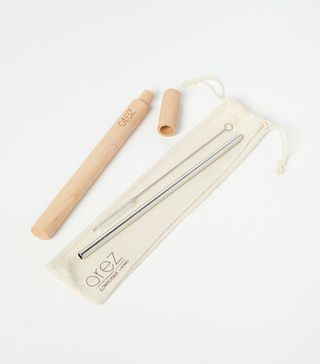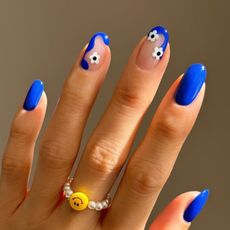What a Dentist Wants You to Know About Whitening Your Teeth at Home
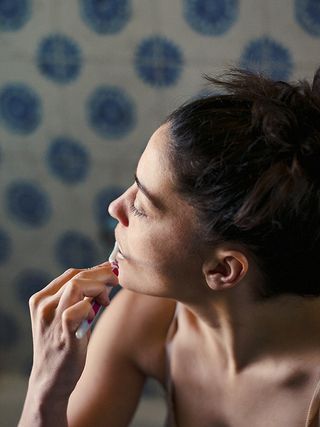
Judging by the sheer number of teeth-whitening products out there, it's never been an easier time to get a brighter smile without leaving your home. There are the traditional toothpastes, whitening trays and strips, and mouthwashes, but there are also newer, high-tech devices that use LED technology. And since there are so many options to choose from, it can be hard to figure out the right one for you, and one that actually works.
The last thing you want to do is shell out money for something that doesn't work at all or that somehow ruins your teeth. To help, we did a little investigating and asked Michaela Tozzi, DMD, for tips on what to look for in teeth-whitening products.

First things first, Tozzi broke down the kinds of products on the market. "There are two main types of bleaching systems on the market," she explains. "The biggest difference between the two is that one system utilizes a light to activate the whitening gel and one does not. There are also pastes, mouthwashes, etc."
When shopping for a product, Tozzi says the priority here should be safety and efficacy. You can do that by reading reviews and doing your own research. It might also help to chat with your dentist about the options available.
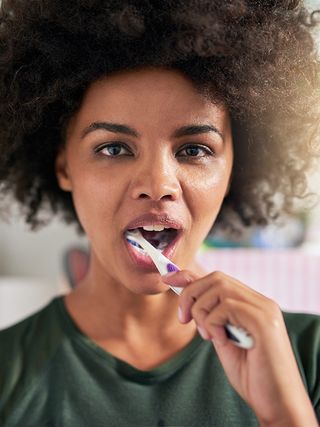
While the type of treatment mostly depends on personal preference, Tozzi recommends staying away from anything that is too abrasive. "For example, charcoal-based whitening pastes can destroy precious enamel leading to sensitivity," she explains. "If they are used for an extended period of time, they can cause the teeth to appear more yellow."
And don't forget to study the ingredient labels carefully. Tozzi says you should steer clear of products that don't have ingredient transparency. The two most common active ingredients in whitening treatments are carbamide peroxide and hydrogen peroxide.

It's important to note that not everyone's smile is suited for at-home teeth whitening. For some people, it might cause more damage than good. "Patients with active decay or periodontal problems may want to avoid at-home whitening treatments, as it can cause extreme sensitivity in these cases," Tozzi says. Overall, it would be best to check with your dentist before using a kit to avoid any future dental problems.
If you can go the at-home route, it's important to follow the product's specific directions, and pay attention to any side effects or reactions. While you can use the product as often as you like—or as recommended by the manufacturer—Tozzi says she advises her patients to use them less frequently once the color they want, or if they are experiencing any teeth or gum sensitivity.
And keep in mind that it's all about moderation. "So many patients like to think that a little whitening gel is good, but excess whitening gel is better," Tozzi explains. "Too much whitening gel can ooze over the gum tissue and cause a chemical burn on your gums (ouch!). If you notice that your gums are white and sensitive after the whitening treatment, the gums were burned. This would indicate that too much gel was applied, or the gel was left in the mouth for too long."
Products aside, in general, if you want to keep your teeth white, you'll want to make sure you're visiting the dentist for regular teeth cleanings and checkups. And for every day, keep a reusable straw with you.
"If you drink coffee, tea, or red wine, drink through a straw to limit the contact with the teeth, Tozzi suggests. "If this doesn't sound enjoyable, rinse with water once you're done imbibing. A mild whitening toothpaste like Klen is great to use on a daily basis to minimize surface stains."
In need of some options? We found some highly rated products below…
Strips, Trays, and Pens
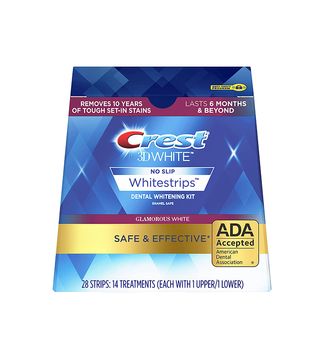
Crest's Whitestrips are probably the most popular at-home whitening kit out there—and Tozzi says they are tried and true. They have a no-slip grip so you can talk and drink water while you're wearing them. They've also got the approval of the American Dental Association.
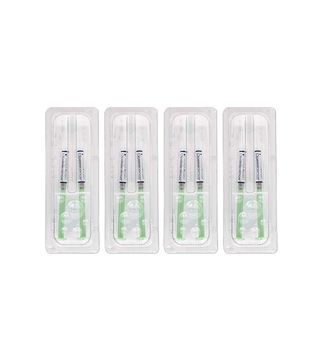
Opalescence's whitening trays are another recommendation by Tozzi. I can also vouch for them, as I've been using this bleaching gel for years. You'll need to get a custom tray made for you at your dentist's office, and all you have to do is apply the gel to the tray and let it work its magic. I find that I only have to use them once a month for upkeep.
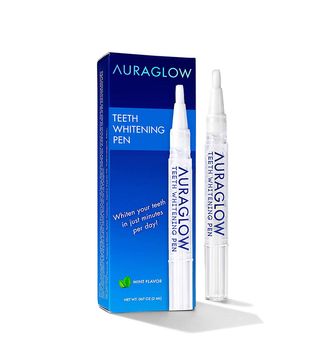
This pen makes it easy to whiten your teeth pretty much anymore. Made with 35% carbamide peroxide, apply the pen to teeth, smile for 60 seconds, and that's it. Make sure you don't eat or drink for an hour after application.
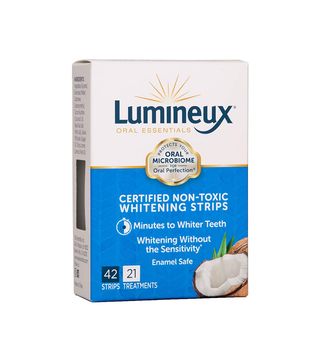
These strips contain coconut oil, lemon peel oil, sage oil, and Dead Sea salt for a gentler whitening experience. The treatment only takes 30 minutes.
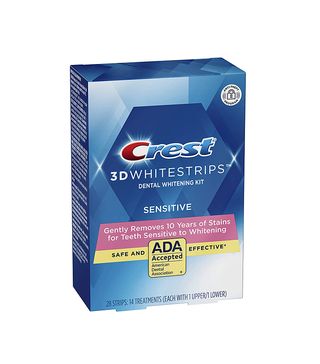
If you have sensitive teeth but still want to try Whitestrips, Crest makes a gentler version for you. They also have the ADA seal of approval.
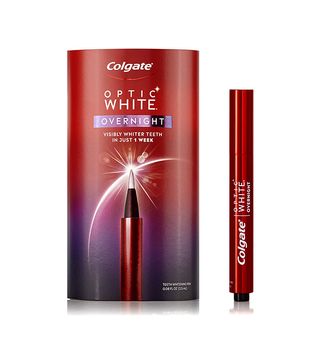
Apply this quick-drying pen to your teeth after you brush your teeth and leave it on overnight. You're supposed to see results after one week of daily use.
LED Treatments
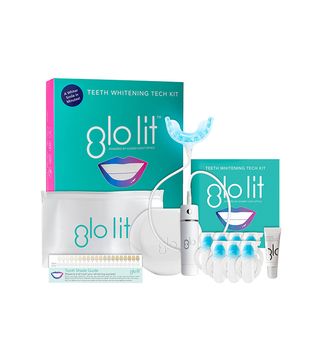
Glo's kit uses heat and blue LED light to whiten teeth. Add the whitening gel to teeth, insert the mouthpiece, and power up. After the mouthpiece turns off after eight minutes, reapply the gel and repeat the process. It's recommended you do this three times for seven consecutive days to see results.
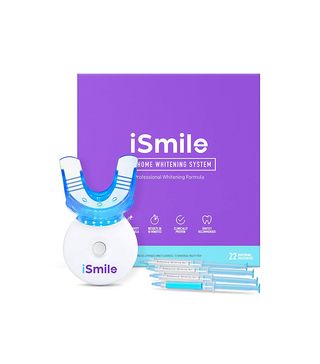
ISmile's whitening formula is made with 35% carbamide peroxide. Each LED tray treatment only takes about 10 minutes. When you first start, it's recommended to use it every day for seven days.
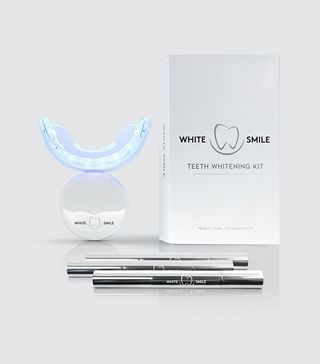
This kit uses both blue-light technology to whiten and red light (to protect against tooth decay, bad breath, and gum inflammation).
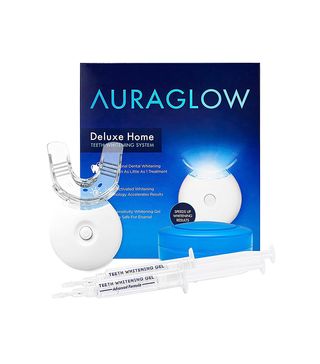
AuraGlow's device has an LED light with five bulbs for extra power, plus a built-in timer and beeper so you don't have to keep track of time. The gel is made with 35% carbamide peroxide, and each treatment takes 30 minutes.
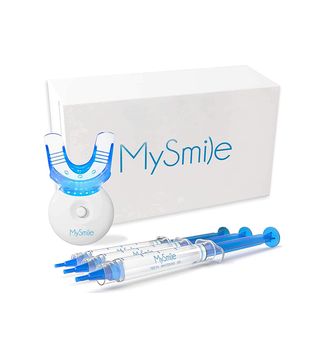
MySmile's whitening gel is formulated for sensitive teeth. The LED light treatment can be done in 10 minutes each day, and it's made to remove food, coffee, and wine stains.
Toothpastes
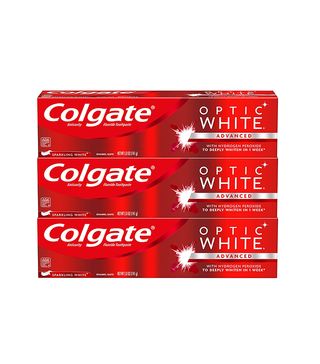
ADA-approved, Colgate's whitening toothpaste works to remove stains beyond the surface, thanks to hydrogen peroxide. Use it twice daily and you should be able to see a difference in a week.
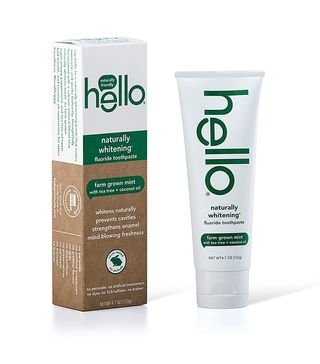
This vegan toothpaste has ingredients coconut oil, aloe vera, xylitol, erythritol, tea tree oil, and farm-grown mint. It's made to whiten teeth but also detoxify, protect against cavities, and freshen your breath.
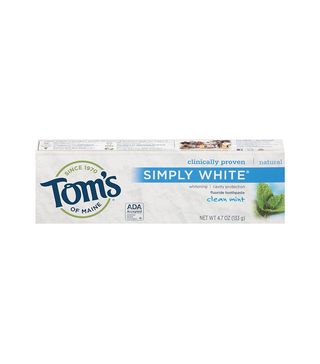
This natural toothpaste from Tom's of Maine is ADA-approved. It contains naturally derived silicas to whiten teeth instead of chemicals. It's also free of artificial flavors, colors, and preservatives.
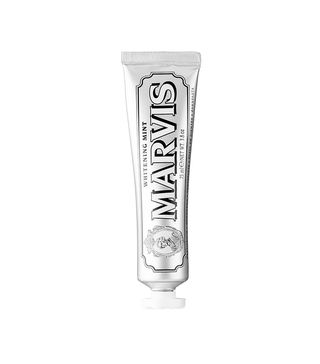
Popular Italian dental care brand Marvis also makes a whitening toothpaste. The formula works to both whiten teeth and prevent tooth decay and plaque buildup.
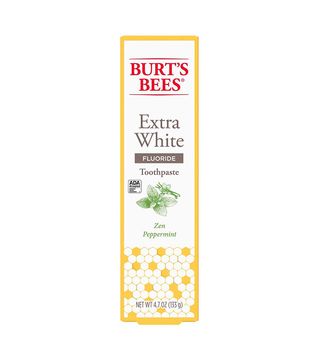
Another toothpaste with the ADA seal, this one from Burt's Bees removes stains with hydrated silica instead of peroxide. It's also made without artificial flavors and sweeteners, preservatives, and dyes.
Mouthwashes
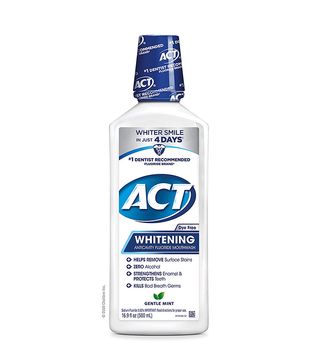
ACT's mouthwash is alcohol-free so you won't feel that burning sensation. This particular formula is made to whiten, strengthen tooth enamel, and freshen breath.
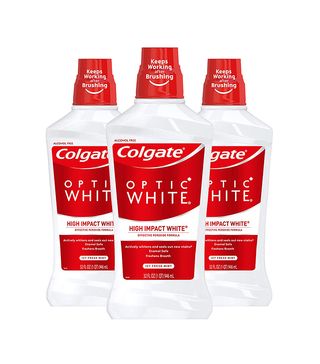
Colgate's hydrogen peroxide formula is enamel-safe and alcohol-free. It works to both whiten teeth and protect against new stains.
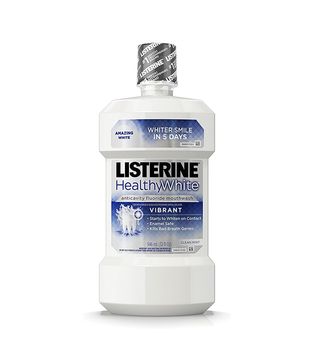
Listerine's HealthyWhite mouthwash is supposed to brighten teeth on contact. The enamel-safe product removes stains and prevents cavities, thanks to fluoride.
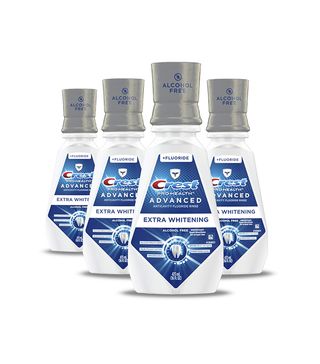
Add this mouthwash to your daily dental routine to whiten teeth, deal with bad breath, prevent cavities, and strengthen enamel. It's also alcohol-free.
Next: 7 Ways to Whiten Teeth Naturally
Disclaimer
This article is provided for informational purposes only and is not intended to be used in the place of advice of your physician or other medical professionals. You should always consult with your doctor or healthcare provider first with any health-related questions.
Sarah is lifestyle writer and editor with over 10 years of experience covering health and wellness, interior design, food, beauty, and tech. Born and raised in Los Angeles, she attended New York University and lived in New York for 12 years before returning to L.A. in 2019.
In addition to her work on THE/THIRTY and Who What Wear, she held editor roles at Apartment Therapy, Real Simple, House Beautiful, Elle Decor, and The Bump (sister site of The Knot).
She has a passion for health and wellness, but she especially loves writing about mental health. Her self-care routine consists of five things: a good workout, “me” time on the regular, an intriguing book/podcast/playlist to unwind after a long day, naps, and decorating her home.
-
 This Founder Shares Why We Should Start Celebrating Rest
This Founder Shares Why We Should Start Celebrating RestBurnout is nothing to be proud of.
By Kia Topps
-
 I Asked J.Lo's Trainer for His Very Best Fitness Tips
I Asked J.Lo's Trainer for His Very Best Fitness TipsGunnar Peterson has thoughts on how to get moving this season.
By Kia Topps
-
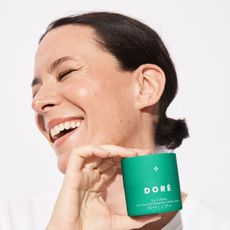 This Style Influencer Turned Founder Shares Her Favorite Ways to Start the Day
This Style Influencer Turned Founder Shares Her Favorite Ways to Start the DayA morning routine from London.
By Candice Aman
-
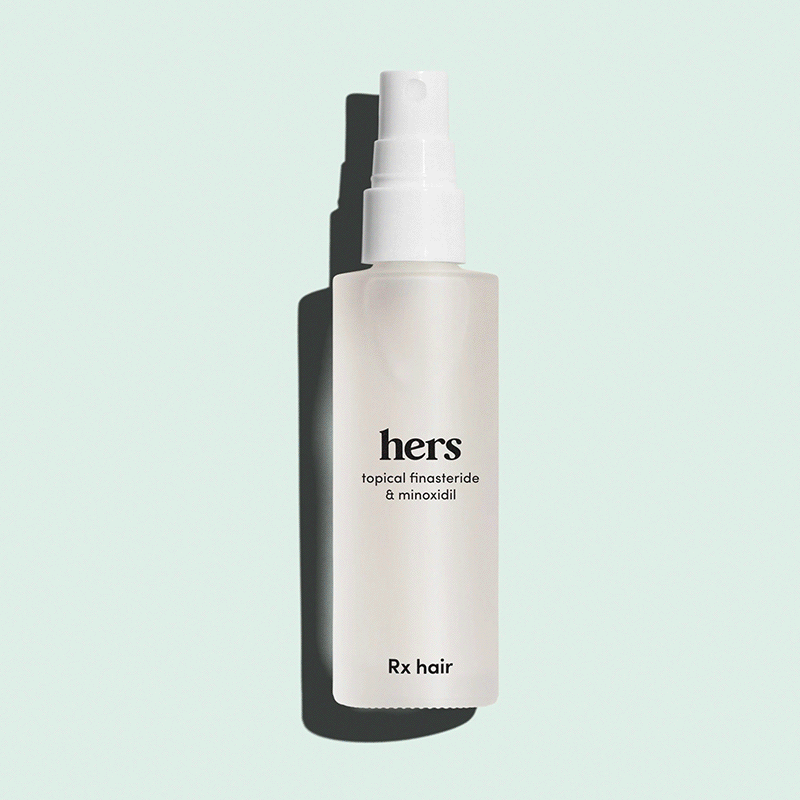 13 Products That Will Step Up Your Self-Care Game From Home
13 Products That Will Step Up Your Self-Care Game From HomeGet that glow from within.
By Natalie Gray Herder
-
 These 8 Foods Are the Worst for Rosacea—Here's What to Eat Instead
These 8 Foods Are the Worst for Rosacea—Here's What to Eat InsteadControl those flare-ups.
By Sarah Yang
-
 If You're Super Stressed Out, These 17 Things Can Make You Feel Better
If You're Super Stressed Out, These 17 Things Can Make You Feel BetterTry them.
By Sarah Yang
-
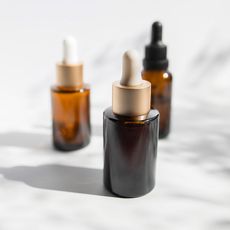 These Essential Oils Will Relieve Your Stress ASAP
These Essential Oils Will Relieve Your Stress ASAPBreathe in. Breathe out.
By Sarah Yang
-
 I Host a Mental Health Podcast—Here Are 5 Important Things I've Learned From It
I Host a Mental Health Podcast—Here Are 5 Important Things I've Learned From ItGive Been Better… HBU? a listen.
By Sarah Yang
